
- Home
- UpFront
- Take One: Big story of the day
- Bhavish Aggarwal wants to change India's automotive landscape. Can he?
Bhavish Aggarwal wants to change India's automotive landscape. Can he?
Ola Electric is setting up a two-wheeler manufacturing facility in Tamil Nadu with 10 million-a-year capacity to herald an EV revolution that is likely to make it a frontrunner in the segment

Manu Balachandran is a writer for Forbes India, based in Bengaluru. At Forbes India, Manu writes on automobiles, aviation, pharmaceuticals, banking, infrastructure, economy and long profiles among many others. He also moderates many of Forbes India's CEO and CXO events and hosts Capital Ideas, a podcast on the most riveting success stories from the business world. He has previously worked with Quartz, The Economic Times and Business Standard in Mumbai and New Delhi. Manu has a master's degree in journalism from Cardiff University and a degree in economics from the Loyola College. When not chasing stories, he is most likely obsessing over Formula 1 (Read: Lewis Hamilton), historical events and people, or planning long weekend drives from Bengaluru
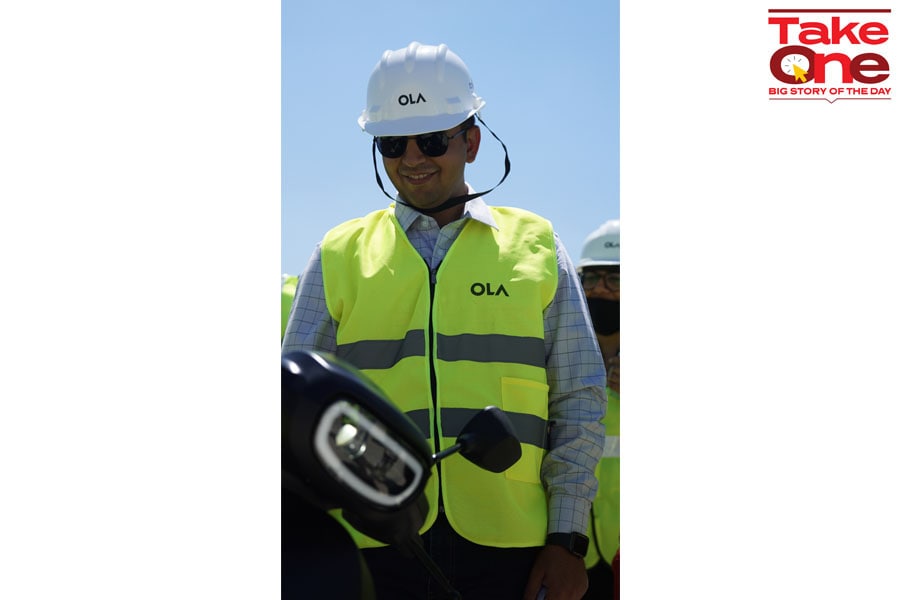
Bhavish Aggarwal is in a hurry. A sort of mad rush.
What else perhaps explains the last few months at Ola Electric, one of India’s fastest unicorns and part of the larger Ola group founded by Aggarwal. The Ola group comprises a mobility business, Ola Cabs and Ola Electric, the electric vehicle arm.
In December 2020, as India’s economy began swinging back to normalcy after months of a nationwide lockdown, Aggarwal and his team at Ola Electric signed a memorandum of understanding with the government of Tamil Nadu to set up a manufacturing plant in the state to produce electric vehicles (EV). It was only a month before that, in November, that the company had signed off on the budget to set up a manufacturing facility.
Then, in January 2021, the company identified a 500-acre plot in Krishnagiri, a tiny hamlet in Tamil Nadu, also known as the mango capital of India, before conducting its ground-breaking ceremony on February 7. A month since, the company has been working at breakneck speed, including replanting trees and excavating land, to turn that barren land into what will be the world’s largest two-wheeler factory.
Once completed, at 10 million units a year, the company will account for 15 percent of the global two-wheeler market in the world.
Even Hero MotoCorp, the world’s largest two-wheeler maker, doesn’t boast a manufacturing facility of this scale. In comparison, across its six manufacturing facilities in India, Hero MotoCorp manufactures 11.6 million units a year, a tad higher than Ola’s proposed facility.
By June, the company will complete the first phase of its manufacturing facility that’s capable of manufacturing some two million two-wheelers. A year from then, the company intends to work at full capacity, capable of manufacturing 10 million units of two-wheelers a year, or one two-wheeler every two seconds. All that means, some 10 million man-hours have been planned to bring the factory up in record time, and by next year, the company will be ready with over 10 million units of its electric two-wheeler.
“Is there any other way?” Aggarwal, chairman and group CEO of Ola, quips about the pace at which the company is planning its EV foray. “In the EV space, the only way we can create impact is to play the scale game. We have to build this business at scale. That’s the only way the adoption of EVs will be faster. Because, unless we build at scale, you can't bring the cost down enough, and you can't get consumers excited.”
Getting customers excited, Aggarwal knows, is certainly the only way out. For years now, India’s consumers have been rather wary about embracing EVs despite a mammoth push from the government. India is a signatory to the Paris Climate Agreement, which means that the country needs to reduce its carbon emissions by some 35 percent of its 2005 levels by 2030 and the government has tried everything—from tax cuts to manufacturing incentives in the automobile sector—to kickstart an EV revolution in the country.
Yet, despite all the narrative around EVs, there haven’t been substantial gains. Last year, India sold some 156,000 units of EVs in the country, of which 126,000 were two-wheelers. In contrast, over 21 million vehicles that run on internal combustion engines (ICE) were sold in FY20, of which 17 million were two-wheelers. China sold some 1.3 million EVs in 2020, according to Singapore-based market research firm Canalys, in a year marked by a pandemic, accounting for over 40 percent of the global EV sales.
Aggarwal wants to change all that and sees a massive opportunity. Not that, he doesn’t have the necessary credentials to bring about a transformation. After all, he changed India’s mobility forever with the launch of Ola, the ride-hailing service that had become the mainstay for shared mobility in the country. “Our vision from the start has been to completely transform all mobility to electric and to do that we have to build a very large integrated manufacturing facility,” says Aggarwal, who co-founded Ola Cabs in 2011.
That’s precisely why Ola Electric has decided to take to manufacturing at such a scale. Within its manufacturing facility is a massive supplier park, a battery manufacturing facility, a welding, and general assembly unit, and a test track among others. The company will invest Rs 2,400 crore towards the first phase of the factory with two million annual capacity, that will be ready this summer.
“The need to transform mobility to electric is there, and we can see what's happening with pollution, so we have to build for the future paradigm, we have to build for future technology, and in mobility, it has to be electric,” Aggarwal says. “It absolutely has to be done as fast as we can.” Perhaps, it’s that commitment to the environment that has also led Aggarwal to set up some 100 acres of forest within the manufacturing facility.
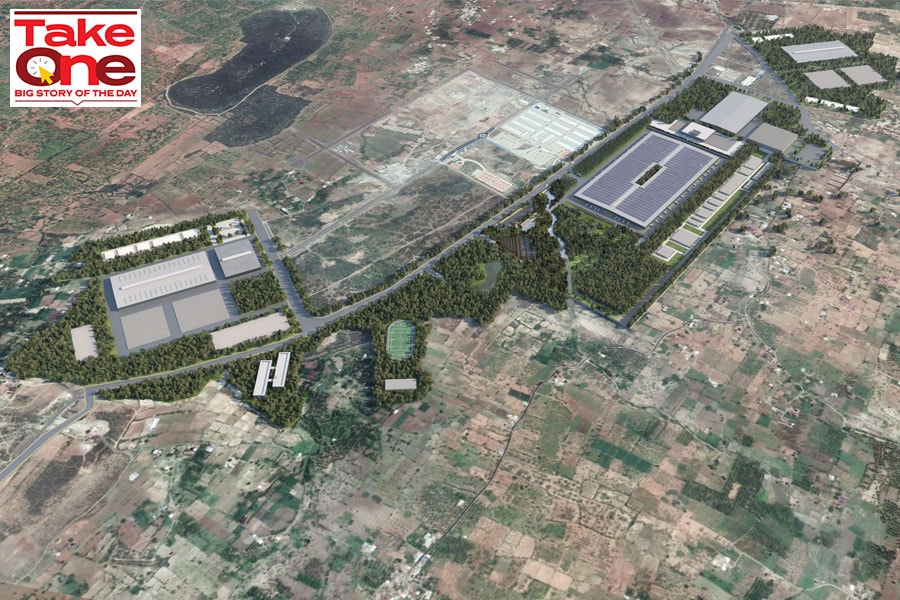 An artist impression of Ola's EV facility when completed
An artist impression of Ola's EV facility when completed
The Big Plan
For now, as much as 90 percent of the components required to manufacture the two-wheeler will be built at the facility in Tamil Nadu. The new facility includes a mega block that’s as big as 150 Olympic-sized swimming pools or the combined size of the T2 terminal at the Mumbai airport and the T3 terminal at Delhi airport.
Barring the battery cells, which the company is importing from South Korea, the rest of the components that go into manufacturing the bike will be sourced from the company’s massive supplier park being built along with the facility. Battery packs are made up of many smaller cells, mostly lithium-ion cells, connected into a battery module, which when wired together determine the final capacity of the battery.
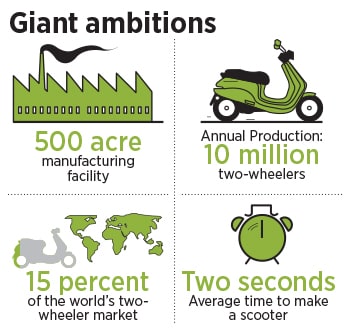 “The cells are coming from outside, but we are making the battery ourselves, including the battery management system,” Aggarwal says. “We want to bring that manufacturing (of cells) to India also.” While there is no definite timeline to when cells will be manufactured in India, it is crucial to do so in India as it can bring down costs even further in the future. Already, the government has announced a production-linked incentive (PLI) scheme to provide financial incentives to manufacturers in the country.
“The cells are coming from outside, but we are making the battery ourselves, including the battery management system,” Aggarwal says. “We want to bring that manufacturing (of cells) to India also.” While there is no definite timeline to when cells will be manufactured in India, it is crucial to do so in India as it can bring down costs even further in the future. Already, the government has announced a production-linked incentive (PLI) scheme to provide financial incentives to manufacturers in the country.
Among others, South Korea, China and Japan account for over 85 percent of the global cell production, and companies such as LG Chemicals, Panasonic, BAK Group and Samsung are the frontrunners in manufacturing them. Lithium-ion batteries can be recharged and have a longer lifecycle with lower maintenance.
Having its own supply ecosystem and localisation are critical for an automaker as they help with reducing costs, bolstering the domestic supply chain, agile need-based customisation, and ensure faster service response. That’s also something that has been missing in India’s electric two-wheeler segment, as EV manufacturers have largely relied on importing parts and simply assembling them within the country. Even others, who have been building from ground-up, are yet to ramp up on their scale and currently boast of capacities less than 100,000 units a year.
“Suppliers will be coming here and investing in this facility, making it a fully vertically integrated plant that also helps reduce cost, and time to market. Those things are critical to driving the adoption of EV,” Aggarwal says. “We're controlling some core technology elements in-house. The battery is designed and manufactured by us, the motor is also designed and manufactured by us, and the vehicle computer and the software are being designed and engineered by us.”
That means, the company will also use some 3,000 robots, which it claims to be the largest in the country, and will use 10 production lines to help with the massive growth plans.
“From a supply perspective, let’s acknowledge that we currently have a cross-border dependency in the EV supply chain and while one may want to localise components such as battery pack, motor, vehicle computer and software, such localisation may be limited to a gross level only and not at a net level,” Harshvardhan Sharma, head of automotive retail practice at Nomura Research Institute Consulting & Solutions India, says. “Furthermore, in terms of demand-side challenges, at a price point of $1,000 (Rs75,000), the users are spread thinner. Remember we are primarily a motorcycle market, not an automatic transmission scooter market, and EV scooters at a premium positioning will have a lower total addressable market compared to an entry-level ICE motorcycles.”
But that’s something Aggarwal hopes to change. The company is yet to announce the price for its two-wheeler, although it reckons that it will be rather aggressive, and matching the ones made by gasoline manufacturers. For comparison, the popular Honda Activa, manufactured by the Japanese automaker Honda, sells at between Rs67,000 and Rs71,000, while Bajaj Chetak, the electric variant of the yesteryear legendary scooter, retails at over Rs100,000. Ola could price its scooter at less than Rs100,000. The company will also likely use subsidies provided under the government’s Faster Adoption and Manufacturing of Hybrid and EV (FAME) scheme, launched in 2015, which provides subsidies and upfront incentives on the purchase of EVs.
“When we launch our product, they'll see the significant advancement we've made on the product itself,” Aggarwal says. “The consumer wants a product which enables better convenience for them and is also available at a reasonable price. So once the technology and price points are there, consumer adoption will be very fast. Our ethos as a company is not to wait for the market to be ready because by that time, you're already too late as an innovator. So we have to create the market and that's what we're doing.”

Will It Find Takers?
Yet, creating a market may not be particularly easy, although Aggarwal has done that before with the success of Ola. For one, while the upfront costs of EVs remain relatively high, there are also serious concerns about range anxiety and poor charging infrastructure in the country.
According to the Central Electricity Authority (CEA), India has 933 public charging stations across the country as of June 2020. Of that, Andhra Pradesh, Telangana and Karnataka have the highest numbers with 433, 160 and 126 units, respectively.
“We have to get the market ready,” Aggarwal says. “The need to do it is there. Unless we transform to electric, we will never be able to get away from our challenges.”
India is currently home to 14 out of the 20 most polluted cities in the world. EVs provide a glimmer of hope by reducing dependence on fossil fuels, and in turn pollution. Of all the vehicles in the country, two-wheelers account for some 79 percent of the total number of vehicles, according to the government’s premier think tank, Niti Aayog. Three-wheelers account for four percent of the total number of vehicles while buses and large goods vehicles like trucks account for three percent.
Economy four-wheelers, which cost less than Rs10 lakh account for 12 percent of the total number of vehicles while premium four-wheelers, costing higher than Rs10 lakh account for two percent.
That’s precisely why Aggarwal has turned his focus to two-wheelers before moving to three-wheelers and four-wheelers over the next few years. “If you look at the electric manufacturers around the world, most of them are focusing on luxury products,” Aggarwal says. “That’s large pickup trucks or luxury sedans or heavy SUVs. The Indian market and most of the world do not need that kind of product. Across most of the world, what’s needed is what I would call urban mobility or mass mobility products. That’s two-wheelers, three-wheelers, four-wheelers, hatchbacks, sedans and small SUVs.”
India’s EV market is expected to grow to 6.3 million units per year by 2027, according to the consultancy firm, India Energy Storage Alliance, growing at a compounded annual growth rate of 44 percent between 2020 and 2027. That’s precisely why iconic EV manufacturer Tesla has also decided to foray into India. But while Tesla may remain unaffordable for many buyers in India, Ola is busy firming up plans to manufacture three-wheelers and four-wheelers soon.
“We're starting with the two-wheeler play… we want to be the world's largest two-wheeler manufacturer in the next few years,” Aggarwal says. “This factory is in that direction, towards that vision of being the world's largest, and will also continue to expand into other segments. We have begun work on that front.” The arrival of Tesla, Aggarwal reckons, will only help catalyse the ecosystem, helping bring excitement among government, customers, and even suppliers.
“The mobility space is such that no one company can transform,” Aggarwal says. “It’s a massive space and it needs a massive transformation where the whole ecosystem has to work together.”
Yet, splurging Rs2,400 crore into a plant to kickstart an EV revolution in India is a big gamble, even for Aggarwal, despite the enormous opportunity. “If you want to change the landscape, you have to have the vision, and also move rather quickly,” says an industry expert who has worked closely with Ola and Aggarwal. “Bhavish is certainly a visionary who has clearly caught the incumbents off guard.”
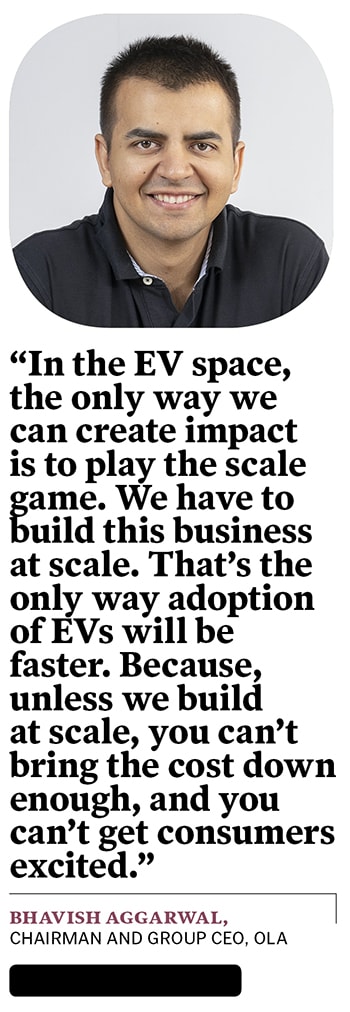 Ola Electric is also planning to set up a charging infrastructure, and is currently laying out plans for the same. India is expected to need a network of over 2.9 million public charging points by FY30, beyond the in-home charging points requiring an investment of over Rs20,000 crore until 2030, according to Niti Aayog.
Ola Electric is also planning to set up a charging infrastructure, and is currently laying out plans for the same. India is expected to need a network of over 2.9 million public charging points by FY30, beyond the in-home charging points requiring an investment of over Rs20,000 crore until 2030, according to Niti Aayog.
“If you look at the future of mobility, the future of mobility will be a multimodal solution,” the 35-year-old Aggarwal says. “There will be shared mobility, where they will use solutions like Ola across the world, but there will be a lot of people who want their own vehicles. But that vehicle needs to represent future technologies and needs to be built using future paradigms. And that's what we're doing. The future of mobility is going to be a balanced one between shared and personal ownership. And we believe we can play a role in it.”
That way building at scale and disrupting the markets could help Ola in the long run, and it could emerge as a frontrunner when the market shifts to EVs over the next few years. India has laid out elaborate plans to have EV sales penetration of 30 percent for private cars, 70 percent for commercial vehicles, 40 percent for buses, and 80 percent for two- and three-wheelers by 2030, fuelled by incentives. Besides, the government is also planning to set up at least one e-charging kiosk at each of the around 69,000 petrol pumps across the country.
“There is a huge opportunity for Ola,” says Puneet Gupta, a director for automotive sales forecasting at consultancy firm IHS Markit. “Existing players such as Hero MotoCorp and Bajaj may not be frontrunners in the segment going forward and that’s an opportunity to cash in on as the first mover. While there are thin margins in EVs now, it will change over a period of time.”
According to Niti Aayog, the country’s EV financing industry is projected to be worth Rs3.7 lakh crore in 2030, about 80 percent of the current retail vehicle finance industry. Between 2020 and 2030, the estimated cumulative capital cost of the country’s EV transition will be Rs19.7 lakh crore across vehicles, electric vehicle supply equipment, and batteries (including replacements).
“We are at an interesting cusp of mobility disruption in India,” adds Sharma of Nomura. “There is action happening on all four areas on CASE (Connected, Autonomous, Shared & Electrical) and electric is at the forefront of it. However, mass adoption of premium EV scooters may percolate from metros to Tier I and eventually Tier II cities. If we were to draw a parallel with the innovation adoption lifecycle, it may be fair to assume that innovators and early adopters may join the bandwagon for this disruption but the critical mass of early majority and late majority customers may take time.”
Many Indian companies, including market leaders such as Maruti Suzuki and Hero Motocorp, are yet to pivot entirely into EVs or invest massively in setting up EVs, even as fuel prices in the country have been seeing record highs. Global automakers, including General Motors and Volkswagen, meanwhile, have taken decisive steps to move into all-electric fleet between 2030 and 2035. In India, companies such as Tata Motors have begun building EVs, while Hero MotoCorp has a 34.58 percent share in Bengaluru-based electric two-wheeler maker, Ather Energy. Hero MotoCorp is also developing a few models in house, and plans to set up charging stations, according to the company’s annual report.
“The incumbents are not ready,” Aggarwal says. “The incumbents haven't invested in enough R&D and enough manufacturing capacity to build products that consumers like in India. The Indian consumer is the smartest, most discerning, and value-conscious customer. They are always ready. The products need to be ready. When we say that markets are not ready, I believe sometimes people mistake that the consumer is not ready.”
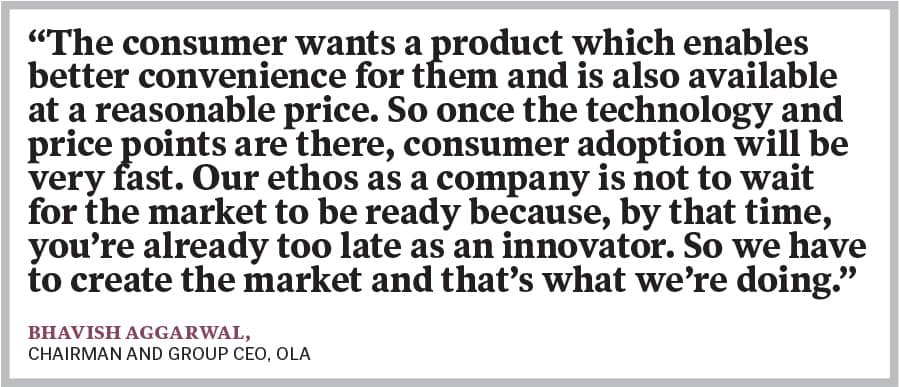
What Happens Now?
Much of Ola’s decision to manufacture two-wheelers in the country comes on the back of its acquisition of Etergo BV, an electric scooter maker based out of Amsterdam.
Etergo, founded in 2014, had built an all-electric state-of-the-art AppScooter that uses swappable high-energy-density batteries to deliver a range of up to 240 km and class-leading acceleration. “It is the same vehicle that will be sold in India,” an insider at Ola Electric tells Forbes India on condition of anonymity. “It has been designed in Europe and is much ahead of its rivals.”
That means the two-wheeler could even match the range provided by electric car makers in the country, and will have more than twice the range offered by Indian electric two wheeler companies. For instance, one of India’s most popular EVs, the Tata Nexon, has an advertised range of 312 km.
“Our pricing will be significantly better than any incumbent EV player in the market,” Aggarwal says. “We're not releasing the pricing right now, but it will be very, very attractive and at par with the ICE variants.” That also means going for a direct-to-customer strategy, followed by the likes of Tesla, in addition to working with partners. At the heart of that sales plan, Aggarwal reckons, will be the leveraging of digital assets. Already, India’s automobile ecosystem has begun moving into virtual sales or online models, as a result of the pandemic.
Meanwhile, even as the Indian market picks up, the company isn’t shying away from exploring the lucrative export market, where EVs have found steam. That means half of the units produced at the manufacturing facility in India will be exported globally, across key markets such as Europe and South America, among others. “We will be doing a significant amount of exports from here, so you can assume about half of our capacity here will be exported across the world,” Aggarwal says.
“India offers the dual advantage of offering strong domestic demand due to a consumption-led economy as well as a favourable export destination advantage due to our cost arbitrage,” adds Sharma of Nomura. “So one option could be taking the mass-premium route, what a Tesla, Nio and Xpeng have done in their markets, but economies of scale is the key here. Another option could be using exports as a strategy. That can bring significant gains quite early in their balance sheet.”
That’s something even Aggarwal could be interested in. For long, Ola Electric had largely remained low-profile since its inception in 2017, without much to show on the books. The company started as a subsidiary of ANI Technologies, the parent company of Ola. By March 2019, it was spun off as a separate unit, with Aggarwal buying out most of the stake in the venture. That was followed by a spate of investments from SoftBank, Hyundai, Kia, Tiger Global, Ratan Tata and the Pawan Munjal family trust, among others, propelling it to a unicorn.
“Shared mobility has been on the backfoot since the Covid-19 crisis,” adds Gupta of IHS Markit. “That’s probably why he has begun focusing more on personal mobility. There have also been significant changes in the business with organisations such as ecommerce and ride-hailing companies looking at moving their entire fleet to EVs. That has given us the confidence to look at this category in a big way.” Aggarwal, meanwhile, reckons that the mobility business is returning to normalcy, and will be back to pre-Covid levels by next quarter.
For now, Aggarwal has his hands full between the mobility and EV business. Every Friday, he travels over three hours from Bengaluru to Krishnagiri to personally inspect the pace of work at the construction site, and holds detailed discussions with the contractors and workers. He knows time is ticking rather fast as June approaches. And, that’s precisely why he is in rush.






